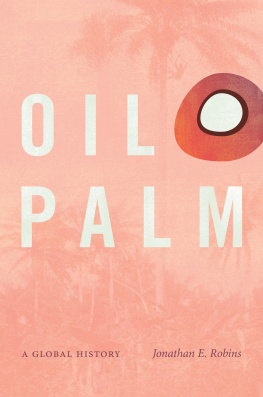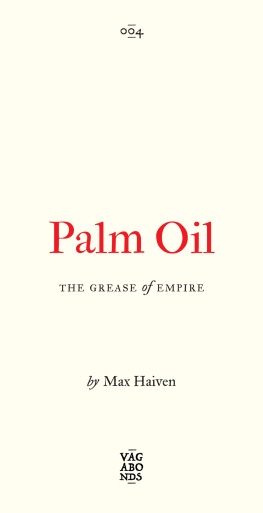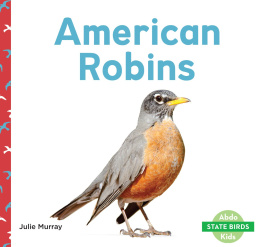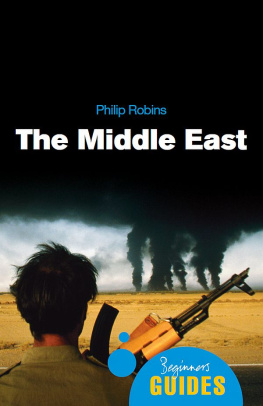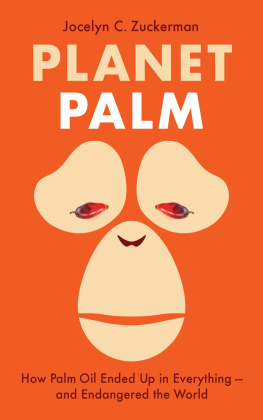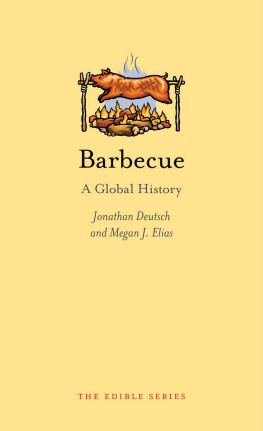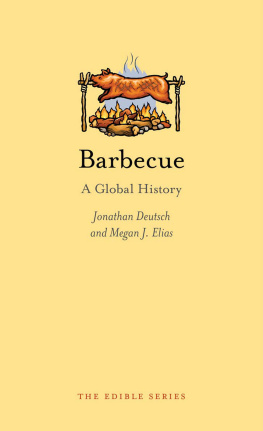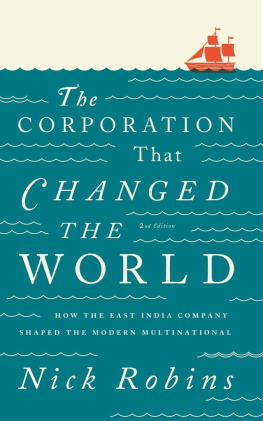Oil Palm
Flows, Migrations, and Exchanges
Mart A. Stewart and Harriet Ritvo, editors
The Flows, Migrations, and Exchanges series publishes new works of environmental history that explore the cross-border movements of organisms and materials that have shaped the modern world, as well as the varied human attempts to understand, regulate, and manage these movements.
Oil Palm
A Global History
JONATHAN E. ROBINS
The University of North Carolina PressChapel Hill
This book was published with the assistance of the Luther H. Hodges Jr. and Luther H. Hodges Sr. Fund of the University of North Carolina Press.
2021 Jonathan E. Robins
All rights reserved
Set in Charis by Westchester Publishing Services
Manufactured in the United States of America
The University of North Carolina Press has been a member of the Green Press Initiative since 2003.
Library of Congress Cataloging-in-Publication Data
Names: Robins, Jonathan, author.
Title: Oil palm : a global history / Jonathan E. Robins.
Other titles: Flows, migrations, and exchanges.
Description: Chapel Hill : University of North Carolina Press, [2021] | Series: Flows, migrations, and exchanges | Includes bibliographical references and index.
Identifiers: LCCN 2020056875 | ISBN 9781469662886 (cloth ; alk. paper) | ISBN 9781469662893 (paperback ; alk. paper) | ISBN 9781469662909 (ebook)
Subjects: LCSH: Palm oil industryAfricaHistory. | Palm oil industrySoutheast AsiaHistory. | Palm oil industryPolitical aspectsHistory. | Oil palmIndustrial applications. | Capitalism.
Classification: LCC HD9490.5.P343 A357 2021 | DDC 338.1/73851096dc23
LC record available at https://lccn.loc.gov/2020056875
Cover illustration: Palm nut harvesting in Cte dIvoire Cirad; black rolled ink texture Shutterstock.com/Itsmesimon.
An earlier version of chapter 7 appeared as Shallow Roots: The Early Oil Palm Industry in Southeast Asia, 18481940, Journal of Southeast Asian Studies 51, no. 4 (2020). Material in chapters 5 and 6 appeared in Food and Drink: Palm Oil versus Palm Wine in Colonial Ghana, Commodities of Empire Working Paper Series 25 (2016); Smallholders and Machines in the West African Palm Oil Industry, African Economic History 46, no. 1 (2018), and Imbibing the Lesson of Defiance: Oil Palms and Alcohol in Colonial Ghana, 190040, Environmental History 23, no. 2 (2018). Material in chapters 4 and 9 appeared in Oil Boom: Agriculture, Chemistry, and the Rise of Global Plant Fat Industries, ca. 18501920, Journal of World History 29, no. 3 (2018).
Contents
Figures, Graphs, and Maps
Figures
Man climbing a tall oil palm with single-rope technique,
Mature oil palms in a Malaysian plantation,
Halved tenera palm fruit impaled on a frond spine,
Tenera palm fruit bunch,
Man tapping oil palm for wine,
Elizabeth Blackwells Oily Palm illustration,
Men making palm oil at Ouidah (Whydah),
Advertisement for Prices Distilled Palm Candles,
Stamp mill for pounding palm fruit,
Clean-weeded palm grove in Congo,
Duchscher-type oil press,
Varieties of palm fruit,
Cover image for The Planter, 1931,
Men carrying Deli palm fruit bunch,
Preserved Deli dura fruit sample,
Artificial pollination of oil palms,
Antipalm oil advertisement, 1986,
Shell advertisement for palm oil substitutes,
Protest poster, ca. 1984,
Graphs
UK palm oil imports and prices, 18181914,
British, French, and German palm oil imports 18401914,
Global trade of palm oil and prices, 18501939,
World vegetable oil supply by type, 19802018,
Maps
Oil palm distribution in Africa,
West Africa during the first palm oil boom,
Colonial Southeast Asia and the major areas for oil palm plantations to 1941,
Abbreviations Used in the Text
CDC
Colonial Development Corporation (Commonwealth Development Corporation in 1963; CDC Group Plc. in 1999)
FAO
Food and Agriculture Organization of the United Nations
FELDA
Federal Land Development Authority
FFA
Free fatty acid
FMS
Federated Malay States
GOPDC
Ghana Oil Palm Development Company
H&C
Harrisons & Crosfield
HCB
Huileries Congo Belge
INEAC
Institut national pour ltude agronomique du Congo belge
IRHO
Institut de recherches pour les huiles et olagineux
MPOB
Malaysian Palm Oil Board
NEI
Netherlands East Indies
NES
Nucleus Estate-Smallholder
NGPI
National Development CorporationGuthrie Philippines
NIFOR
Nigerian Institute for Oil Palm Research
PNG
Papua New Guinea
POEM
Palm Oil Estates Managers, Ltd.
PORIM
Palm Oil Research Institute of Malaysia
RBD
Refined, bleached, deodorized
RSPO
Roundtable for Sustainable Palm Oil
SOCFIN
Socit Financire des Caoutchoucs
UAC
United Africa Company
UFC
United Fruit Company
WAIFOR
West African Institute for Oil Palm Research
Oil Palm
Introduction
In 1841, a Liberian colonist delivered a piece of advice to African Americans contemplating a new start in the fledgling West African state: plant oil palms. Besides being the most beautiful trees, their fruit yielded an oil that was altogether preferred by the colonists to lard. The young stem of the palm could be eaten as a vegetable, and one could tap a very pleasant wine from older trees. Featured prominently on Liberias official seal, the oil palm seemed to be a living symbol of Africas tropical bounty. One writer predicted that palm oil would soon be one of the heaviest articles of traffic in the commercial world.
Palm oil has indeed become one of the worlds most important agricultural commodities. Extracted from the flesh of the oil palms fruit, palm oil is the most widely consumed fat on the planet. Its in cooking oil, peanut butter, cookies and crackers, soaps, cosmetics, plastics, and biodiesel. Palm kernel oil, extracted from the nut at the center of the fruit, serves in nearly as many roles. What the prognosticators of the 1840s got wrong was where and how this would happen. Farmers and settlers across western Africa launched palm oil as a global commodity in the nineteenth century. Yet today, the vast majority of the worlds palm oil comes from Southeast Asia. Africa now imports ten times more palm oil than it exports.
This book traces the history of that remarkable reversal, following the oil palms journeys out of Africa and the development of palm oil as a commodity. Not a natural history of Elaeis guineensis (the Linnaean name for the oil palm), this is rather the story of how humans used and lived with oil palmsa history that has been anything but natural. Humans shaped where and how oil palms were cultivated and what ends they served. The dominant role of palm oil in todays food system owes something to the plants innate biology but much more to political and economic power. The people who grew and harvested oil palms, rather the tree itself, are what made palm oil cheap and plentiful on the world market. Historically, many of the people doing that labor werent free to choose how they worked with this plant. Elites, states, and corporations shaped systems of production, making and remaking oil palm landscapes to suit their interests. Its a story shot through with the stark realities of power and injustice, of slavery, colonialism, and violence. Yet its also a story of opportunity: of farmers taking up oil palm on their own initiative or joining pioneering settlements, seeing the promise of a better life in neat rows of palms.

